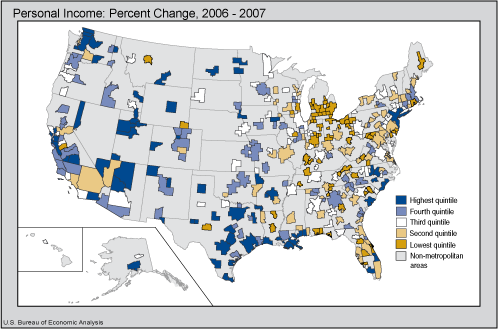WASHINGTON DC, August 7, 2008 - Personal income growth slowed in 2007 in most of the nation's metropolitan statistical areas (MSAs), according to estimates released today by the U.S. Bureau of Economic Analysis. On average, MSA personal income grew 6.2% in 2007, down from 6.8% in 2006. Personal income growth slowed in 208 MSAs, increased in 144, and remained unchanged in 11 MSAs.

Personal income in the three fastest growing MSAs, Gulfport, MS; New Orleans, LA; and Pascagoula, MS, was boosted by federal payments to rebuild residences destroyed or damaged by Hurricane Katrina in 2005. These payments, arising from homeowner assistance programs initiated at the end of December 2006, are counted as part of the property income component of personal income.
In five of the next ten fastest growing MSAs (Odessa, TX; Grand Junction, CO; Midland, TX; Casper, WY; and Houston, TX), the oil and gas extraction industry provided a bigger contribution to growth than any other industry. In addition, transportation services in support of offshore oil and gas platforms was largely responsible for Houma, LA's ranking among the top ten.
The twenty slowest growing MSAs were all in the Great Lakes Region (Michigan, Ohio, Indiana, Illinois, and Wisconsin). Personal income growth in most of these MSAs was one-half the national pace or less as compensation declined in the durable goods manufacturing sector, often by substantial amounts. In some cases, compensation in 2006 had been boosted by the acceptance of employee buyout offers from automakers while 2007 compensation reflected a smaller workforce and pay concessions in the auto and auto parts industries.
Construction reduced personal income growth by 0.5 percentage point or more in 18 MSAs, half of which are in Florida. These Florida MSAs either lost population or had slower population growth in 2007 than in 2006.
Per capita income. Per capita personal income growth rates ranged from 17% in Pascagoula, MS to -0.5% in Palm Coast, FL. Per capita personal income growth is a measure which highlights differences in economic conditions across MSAs by removing the effect of differential population growth rates.
On a per capita basis, the five fastest growing MSAs by this measure are in Louisiana and Mississippi (Pascagoula, MS; Gulfport, MS; New Orleans, LA; Houma, LA; and Lake Charles, LA), reflecting the federal payments already mentioned as well as activity at shipyards in Pascagoula, casinos and other services in the accommodations industry in Gulfport, state and local government in New Orleans, and construction in Houma and Lake Charles.
Four of the ten MSAs with the slowest growing per capita personal income are in Florida (Cape Coral, Ocala, Lakeland, and Palm Coast) while only two are in the Great Lakes region (Monroe, MI and Flint, MI).
Definitions
Personal income is the income received by all persons from all sources. Personal income is the sum of net earnings by place of residence, rental income of persons, personal dividend income, personal interest income, and personal current transfer receipts. Net earnings is earnings by place of work (the sum of wage and salary disbursements (payrolls), supplements to wages and salaries, and proprietors' income) less contributions for government social insurance, plus an adjustment to convert earnings by place of work to a place-of-residence basis. Personal income is measured before the deduction of personal income taxes and other personal taxes and is reported in current dollars (no adjustment is made for price changes).
Per capita personal income is calculated as the personal income of the residents of a given area divided by the resident population of the area. In computing per capita personal income, BEA uses the Census Bureau's annual midyear population estimates.
The metropolitan area definitions used by BEA for its entire series of personal income estimates are the county-based definitions developed by the Office of Management and Budget (OMB) for federal statistical purposes and last updated in November 2007. OMB's general concept of a metropolitan area is that of a geographic area consisting of a large population nucleus together with adjacent communities having a high degree of economic and social integration with the nucleus. Personal income and per capita personal income estimates for the 363 metropolitan areas are shown in Table 1.
The complete set of advance metropolitan area income estimates for 2007, as well as previously published estimates for 1969-2006, is now available interactively on BEA's Web site. Detailed annual estimates of compensation of employees by industry and components of personal income are available. Currently, these estimates are the only detailed, broadly inclusive, annual measures of economic activity available for metropolitan areas. To access these estimates, go to www.bea.gov/regional/reis/ and select table AMSA.
Data on personal income and per capita personal income for BEA metropolitan areas will be presented in the September issue of the Survey of Current Business, the monthly journal of the Bureau of Economic Analysis.
BEA's national, international, regional, and industry estimates; the Survey of Current Business; and BEA news releases are available without charge on BEA's Web site at www.bea.gov. By visiting the site, you can also subscribe to receive free e-mail alerts of BEA releases and announcements.
For further information, call (202) 606-5360.
****
The next metropolitan area economic data release, scheduled for September 25, 2008 at 8:30 A.M. ET, will be Gross Domestic Product by Metropolitan Area, 2006.





